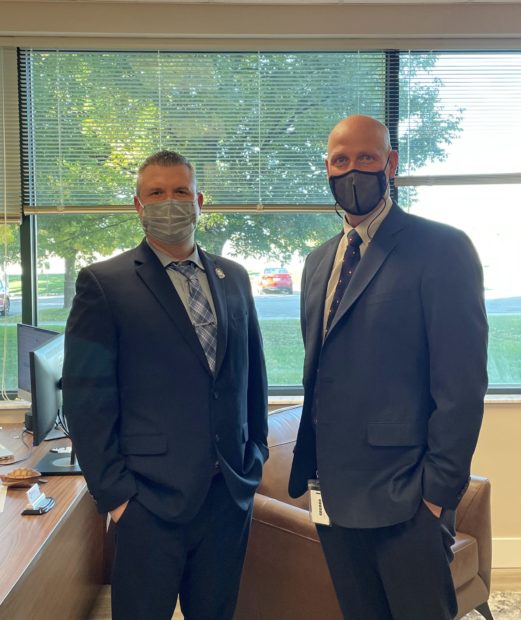
Idaho’s largest school district has over $30 million in federal relief on tap to help it recover from the pandemic. In the West Ada School District’s first school year of continuous, full-time in-person instruction since 2019, administrators have high hopes.
They’re in the process of hiring instructional coaches, seeking on-demand tutoring for students and buying laptops with the money provided by the American Rescue Plan (ARP), the third round of federal coronavirus relief passed last spring. District leaders hope the funding windfall will help students rebound from two school years in which hybrid and online learning dealt setbacks to students’ learning.
“We’re in a challenging time right now, in Idaho and in the United States,” Superintendent Derek Bub told Idaho Education News last week. “But it’s also a really rewarding time in regards to — we have some flexibility and some ability to really hone in on where our kids’ learning loss is, what our kids need, so we can individualize their education.”
The district’s plans for spending the money were developed throughout the summer and fall, as two thirds of the money became available to school districts and charter schools in July. As with all other charters and districts in the state, West Ada’s plan was required to be posted on its website by Oct. 1, and now that it has, stakeholders can track the district’s emergence from the pandemic.
West Ada is putting more of its money into math than any other subject, especially for students making the jump from elementary to middle school, and middle school to high school. Experts have said math was especially challenging to teach online, and losses in the subject have been especially pronounced, as Education Week reported.
To measure its success, in math and reading, the district will use a patchwork of numbers to track students’ recovery from the pandemic. Those include standardized test scores from the Idaho Reading Indicator and Idaho Standards Achievement Test. But they also include the rate of “F’s” students receive, and graduation rates.
While math and reading are both getting a share of district funds, the largest chunk of West Ada’s federal money will pay for internet-enabled devices like laptops for K-5 students, even though teachers, parents and students placed the purchase of more tech low on their list of priorities in a recent district survey.
Many of those students are using aging devices that may wear out in the next year or two, making near-term upgrades to the district’s tech infrastructure a must if it hopes to sustain a one-to-one device supply built up to support online learning earlier in the pandemic, Bub said. To match, tech investments will comprise $12.4 million of the district’s spending, close to one third of its ARP cash.
But as with the hiring of new staff members, the use of one-time money to replace a fleet of laptops leaves a hole in the budget picture for future school years.
The so-called “funding cliffs” that one-time cash infusions can create pose a challenge to districts across the country as they try to strike a balance between counteracting learning loss from the pandemic and catching up with needs that state and local funding haven’t been able to cover in years past.
“Anytime you’re spending one-time money, that’s the risk you’re going to take,” said Bub.
In the meantime, administrators plan to take on additional staff members and services, like the tutoring programs West Ada plans to use. Once funding dries up, they’ll reevaluate, keeping programs that proved most effective and making cuts where needed to make that possible.
“If we’re not able to sustain the hiring of more people, then what we’ve really done is just build professional capacity so that we can continue with the good work, despite having less people,” said Chief Academic Officer Marcus Myers.
That process could prove especially crucial for low-income students and English-language learners, who, across the U.S., fell even further behind on standardized tests during the pandemic than they had been in years past.
One of ARP’s central goals in addressing learning loss was targeting low-income students, and it allocated more money to low-income districts to do so. Within West Ada’s plan for spending its money, leaders haven’t specifically said disadvantaged students or schools will get the bulk of the district’s money — programs like online tutoring will be offered to all students, as will others — but instructional coaches may be sent to schools with high need, said Meyers. And West Ada’s plan focuses explicitly on social-emotional learning, including hiring school counselors, in an effort to bolster support for disadvanataged students who may most benefit from added support.
The district is bringing on added staff in special education, too, in hopes of helping a group of students who had added challenges with remote learning.
But before West Ada spends its latest injection of money, it still has more to spend from the second round of federal relief, state reporting shows. As of Sept. 28, the district hasn’t submitted reimbursements from the some $15 million it received from the second round, and it’s only tapped about one third of its $3 million from the first round of federal pandemic relief. Since districts can spend money on eligible costs and then submit paperwork for reimbursements from those funding pots, it’s possible West Ada has worked through more of the windfalls. But as Myers noted, “It’s still early.”
Districts and charters have until Sept. 30, 2023 to spend the last round of money. And Idaho may apply for a waiver that would extend that deadline by a year.
